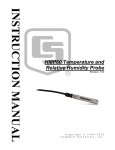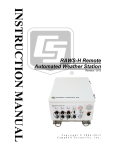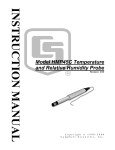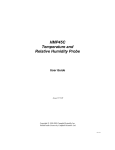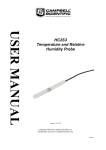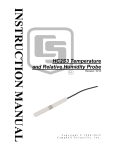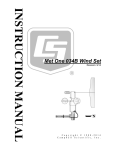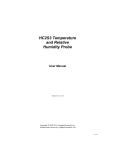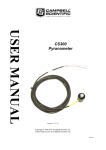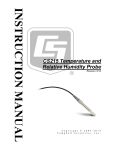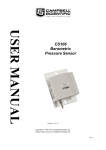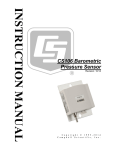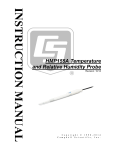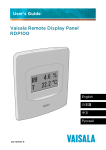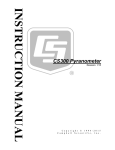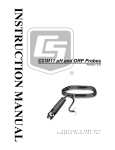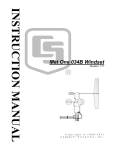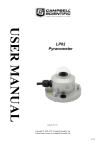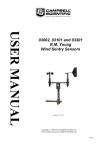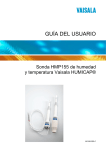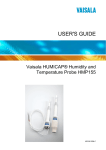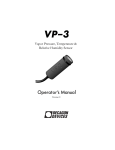Download HMP60 Temperature and Relative Humidity Probe
Transcript
USER MANUAL HMP60 Temperature and Relative Humidity Probe Issued: 11.8.15 Copyright 1995-2015 Campbell Scientific, Inc. Printed under licence by Campbell Scientific Ltd. CSL 896 Guarantee This equipment is guaranteed against defects in materials and workmanship. This guarantee applies for 24 months from date of delivery. We will repair or replace products which prove to be defective during the guarantee period provided they are returned to us prepaid. The guarantee will not apply to: Equipment which has been modified or altered in any way without the written permission of Campbell Scientific Batteries Any product which has been subjected to misuse, neglect, acts of God or damage in transit. Campbell Scientific will return guaranteed equipment by surface carrier prepaid. Campbell Scientific will not reimburse the claimant for costs incurred in removing and/or reinstalling equipment. This guarantee and the Company’s obligation thereunder is in lieu of all other guarantees, expressed or implied, including those of suitability and fitness for a particular purpose. Campbell Scientific is not liable for consequential damage. Please inform us before returning equipment and obtain a Repair Reference Number whether the repair is under guarantee or not. Please state the faults as clearly as possible, and if the product is out of the guarantee period it should be accompanied by a purchase order. Quotations for repairs can be given on request. It is the policy of Campbell Scientific to protect the health of its employees and provide a safe working environment, in support of this policy a “Declaration of Hazardous Material and Decontamination” form will be issued for completion. When returning equipment, the Repair Reference Number must be clearly marked on the outside of the package. Complete the “Declaration of Hazardous Material and Decontamination” form and ensure a completed copy is returned with your goods. Please note your Repair may not be processed if you do not include a copy of this form and Campbell Scientific Ltd reserves the right to return goods at the customers’ expense. Note that goods sent air freight are subject to Customs clearance fees which Campbell Scientific will charge to customers. In many cases, these charges are greater than the cost of the repair. Campbell Scientific Ltd, 80 Hathern Road, Shepshed, Loughborough, LE12 9GX, UK Tel: +44 (0) 1509 601141 Fax: +44 (0) 1509 601091 Email: [email protected] www.campbellsci.co.uk PLEASE READ FIRST About this manual Please note that this manual was originally produced by Campbell Scientific Inc. primarily for the North American market. Some spellings, weights and measures may reflect this origin. Some useful conversion factors: Area: 1 in2 (square inch) = 645 mm2 Length: Mass: 1 in. (inch) = 25.4 mm 1 ft (foot) = 304.8 mm 1 yard = 0.914 m 1 mile = 1.609 km 1 lb (pound weight) = 0.454 kg Pressure: 1 psi (lb/in2) = 68.95 mb Volume: 1 UK pint = 568.3 ml 1 UK gallon = 4.546 litres 1 US gallon = 3.785 litres 1 oz. (ounce) = 28.35 g In addition, while most of the information in the manual is correct for all countries, certain information is specific to the North American market and so may not be applicable to European users. Differences include the U.S standard external power supply details where some information (for example the AC transformer input voltage) will not be applicable for British/European use. Please note, however, that when a power supply adapter is ordered it will be suitable for use in your country. Reference to some radio transmitters, digital cell phones and aerials may also not be applicable according to your locality. Some brackets, shields and enclosure options, including wiring, are not sold as standard items in the European market; in some cases alternatives are offered. Details of the alternatives will be covered in separate manuals. Part numbers prefixed with a “#” symbol are special order parts for use with non-EU variants or for special installations. Please quote the full part number with the # when ordering. Recycling information At the end of this product’s life it should not be put in commercial or domestic refuse but sent for recycling. Any batteries contained within the product or used during the products life should be removed from the product and also be sent to an appropriate recycling facility. Campbell Scientific Ltd can advise on the recycling of the equipment and in some cases arrange collection and the correct disposal of it, although charges may apply for some items or territories. For further advice or support, please contact Campbell Scientific Ltd, or your local agent. Campbell Scientific Ltd, 80 Hathern Road, Shepshed, Loughborough, LE12 9GX, UK Tel: +44 (0) 1509 601141 Fax: +44 (0) 1509 601091 Email: [email protected] www.campbellsci.co.uk Precautions DANGER — MANY HAZARDS ARE ASSOCIATED WITH INSTALLING, USING, MAINTAINING, AND WORKING ON OR AROUND TRIPODS, TOWERS, AND ANY ATTACHMENTS TO TRIPODS AND TOWERS SUCH AS SENSORS, CROSSARMS, ENCLOSURES, ANTENNAS, ETC. FAILURE TO PROPERLY AND COMPLETELY ASSEMBLE, INSTALL, OPERATE, USE, AND MAINTAIN TRIPODS, TOWERS, AND ATTACHMENTS, AND FAILURE TO HEED WARNINGS, INCREASES THE RISK OF DEATH, ACCIDENT, SERIOUS INJURY, PROPERTY DAMAGE, AND PRODUCT FAILURE. TAKE ALL REASONABLE PRECAUTIONS TO AVOID THESE HAZARDS. CHECK WITH YOUR ORGANIZATION'S SAFETY COORDINATOR (OR POLICY) FOR PROCEDURES AND REQUIRED PROTECTIVE EQUIPMENT PRIOR TO PERFORMING ANY WORK. Use tripods, towers, and attachments to tripods and towers only for purposes for which they are designed. Do not exceed design limits. Be familiar and comply with all instructions provided in product manuals. Manuals are available at www.campbellsci.eu or by telephoning +44(0) 1509 828 888 (UK). You are responsible for conformance with governing codes and regulations, including safety regulations, and the integrity and location of structures or land to which towers, tripods, and any attachments are attached. Installation sites should be evaluated and approved by a qualified engineer. If questions or concerns arise regarding installation, use, or maintenance of tripods, towers, attachments, or electrical connections, consult with a licensed and qualified engineer or electrician. General • Prior to performing site or installation work, obtain required approvals and permits. Comply with all governing structure-height regulations, such as those of the FAA in the USA. • Use only qualified personnel for installation, use, and maintenance of tripods and towers, and any attachments to tripods and towers. The use of licensed and qualified contractors is highly recommended. • Read all applicable instructions carefully and understand procedures thoroughly before beginning work. • Wear a hardhat and eye protection, and take other appropriate safety precautions while working on or around tripods and towers. • Do not climb tripods or towers at any time, and prohibit climbing by other persons. Take reasonable precautions to secure tripod and tower sites from trespassers. • Use only manufacturer recommended parts, materials, and tools. Utility and Electrical • You can be killed or sustain serious bodily injury if the tripod, tower, or attachments you are installing, constructing, using, or maintaining, or a tool, stake, or anchor, come in contact with overhead or underground utility lines. • Maintain a distance of at least one-and-one-half times structure height, or 20 feet, or the distance required by applicable law, whichever is greater, between overhead utility lines and the structure (tripod, tower, attachments, or tools). • Prior to performing site or installation work, inform all utility companies and have all underground utilities marked. • Comply with all electrical codes. Electrical equipment and related grounding devices should be installed by a licensed and qualified electrician. Elevated Work and Weather • Exercise extreme caution when performing elevated work. • Use appropriate equipment and safety practices. • During installation and maintenance, keep tower and tripod sites clear of un-trained or non-essential personnel. Take precautions to prevent elevated tools and objects from dropping. • Do not perform any work in inclement weather, including wind, rain, snow, lightning, etc. Maintenance • Periodically (at least yearly) check for wear and damage, including corrosion, stress cracks, frayed cables, loose cable clamps, cable tightness, etc. and take necessary corrective actions. • Periodically (at least yearly) check electrical ground connections. WHILE EVERY ATTEMPT IS MADE TO EMBODY THE HIGHEST DEGREE OF SAFETY IN ALL CAMPBELL SCIENTIFIC PRODUCTS, THE CUSTOMER ASSUMES ALL RISK FROM ANY INJURY RESULTING FROM IMPROPER INSTALLATION, USE, OR MAINTENANCE OF TRIPODS, TOWERS, OR ATTACHMENTS TO TRIPODS AND TOWERS SUCH AS SENSORS, CROSSARMS, ENCLOSURES, ANTENNAS, ETC. Contents PDF viewers: These page numbers refer to the printed version of this document. Use the PDF reader bookmarks tab for links to specific sections. 1. Introduction ................................................................ 1 2. Cautionary Statements .............................................. 1 3. Initial Inspection ........................................................ 1 4. Quickstart ................................................................... 2 5. Overview ..................................................................... 4 6. Specifications ............................................................ 4 6.1 6.2 Temperature Sensor ............................................................................. 5 Relative Humidity Sensor .................................................................... 5 7. Installation .................................................................. 5 7.1 7.2 Wiring to Datalogger ........................................................................... 5 Datalogger Programming ..................................................................... 6 7.2.1 VoltSE() Instruction ...................................................................... 6 7.3 Installation............................................................................................ 7 7.3.1 Installation in a 41303-5A or 41303-5B 6-Plate Shield ................ 8 7.3.2 Installation in a RAD06 6-Plate Shield or RAD10 10-Plate Shield ......................................................................................... 8 7.3.3 Mount the Shield ........................................................................... 8 8. Operation .................................................................... 9 8.1 8.2 Measurement ........................................................................................ 9 Long Lead Lengths .............................................................................. 9 9. Troubleshooting and Maintenance ......................... 10 9.1 9.2 Troubleshooting ................................................................................. 10 Maintenance ....................................................................................... 10 9.2.1 Procedure for Removing RH Chip .............................................. 11 10. Attributions and References ................................... 11 Appendices A. Importing Short Cut Code to CRBasic Editor ...... A-1 B. Example Program .................................................. B-1 C. Absolute Humidity ................................................. C-1 C.1 CR1000 Vapour Pressure Example .................................................. C-1 i Figures 7-1. 7-2. 7-3. 7-4. 9-1. HMP60 as shipped ............................................................................... 8 HMP60 and 41303-5A Radiation Shield ............................................. 8 HMP60 and 41303-5A Radiation Shield on a tripod mast (left) and on a CM202 Crossarm (right) .................................................... 9 HMP60 and RAD06 Radiation Shield on a tripod mast ...................... 9 Exploded view of HMP60 (as shipped) ............................................. 11 7-1. Wire Colour, Function, and Datalogger Connection ............................ 6 Tables ii HMP60 Temperature and Relative Humidity Probe 1. Introduction The HMP60 probe measures temperature for the range of –40 to 60 °C, and relative humidity for the range of 0 to 100% RH. It is suitable for long-term, unattended monitoring, and is compatible with all Campbell Scientific dataloggers. For Edlog datalogger support, check the availability of an older manual at www.campbellsci.com/old-manuals, or contact a Campbell Scientific application engineer for assistance. 2. 3. Cautionary Statements READ AND UNDERSTAND the Precautions section at the front of this manual. When opening the shipping package, do not damage or cut the cable jacket. If damage to the cable is suspected, consult with a Campbell Scientific application engineer. Although rugged, the HMP60 should be handled as a precision scientific instrument. Remove the yellow cap prior to installation. Santoprene® rubber, which composes the black outer jacket of the 107 cable, will support combustion in air. It is used because of its resistance to temperature extremes, moisture, and UV degradation. It is rated as slow burning when tested according to U.L. 94 H.B. and passes FMVSS302. However, local fire codes may preclude its use inside buildings. Initial Inspection Check the packaging and contents of the shipment. If damage occurred during transport, immediately file a claim with the carrier. Contact Campbell Scientific to facilitate repair or replacement. Check model information against the shipping documents to ensure the expected products and the correct lengths of cable are received. Model numbers are found on each product. On cables and cabled items, the model number is usually found at the connection end of the cable. Report any shortages immediately to Campbell Scientific. The HMP60 ships with a ResourceDVD. 1 HMP60 Temperature and Relative Humidity Probe 4. Quickstart Short Cut is an easy way to program your datalogger to measure the HMP60 sensor and assign datalogger wiring terminals. Use the following procedure to get started. 2 1. Install Short Cut by clicking on the install file icon. Get the install file from either www.campbellsci.com, the ResourceDVD, or find it in installations of LoggerNet, PC200W, PC400, or RTDAQ software. 2. The Short Cut installation should place a shortcut icon on the desktop of your computer. To open Short Cut, click on this icon. 3. When Short Cut opens, select New Program. User Manual 4. Select Datalogger Model and Scan Interval (default of 5 seconds is OK for most applications). Click Next. 5. Under the Available Sensors and Devices list, select the Sensors folder, then select the Meteorological | Relative Humidity & Temperature sub-folder. Select HMP50/HMP60 Temperature & Relative Humidity Sensor. Click to move the selection to the Selected device window. Data defaults to degree Celsius. This can be changed by clicking the Deg C box and selecting Deg F, for degrees Fahrenheit, or K for Kelvin. 3 HMP60 Temperature and Relative Humidity Probe 5. 6. After selecting the sensor, click at the left of the screen on Wiring Diagram to see how the sensor is to be wired to the datalogger. The wiring diagram can be printed out now or after more sensors are added. 7. Select any other sensors you have, and then finish the remaining Short Cut steps to complete the program. The remaining steps are outlined in Short Cut Help, which is accessed by clicking on Help | Contents | Programming Steps. 8. If LoggerNet, PC400, RTDAQ, or PC200W is running on your PC, and the PC to datalogger connection is active, you can click Finish in Short Cut and you will be prompted to send the program just created to the datalogger. 9. If the sensor is connected to the datalogger, as shown in the wiring diagram in step 6, check the output of the sensor in the datalogger support software data display to make sure it is making reasonable measurements. Overview The HMP60 Temperature and Relative Humidity probe contains a Platinum Resistance Temperature detector (PRT) and a Vaisala INTERCAP ® capacitive relative humidity sensor. It is suitable for long-term, unattended monitoring. The humidity chip is field-replaceable, eliminating recalibration downtime. 6. Specifications Features: 4 Field-replaceable humidity chip eliminates recalibration down time Compatible with the CWS900-series interfaces, allowing it to be used in a wireless sensor network Compatible with the following CRBasic dataloggers: CR200(X) series, CR6, CR800 series, CR1000, CR3000, CR5000, CR9000(X) Operating Temperature: –40 to 60 C Probe Length: 7.1 cm (2.8 in) Probe Body Diameter: 1.2 cm (0.47 in) User Manual 6.1 6.2 Filter: 0.2 m Teflon membrane Filter Diameter: 1.2 cm (0.47 in) Housing Body Material: Filter Cap Material: Classification: AISI 316 stainless steel Chrome-coated ABS plastic IP65 Power Consumption: 1 mA typical; 5 mA maximum Supply Voltage: 5 to 28 Vdc Settling Time after power is switched on: 1s Output Signal Range: 0 to 1 Vdc Temperature Sensor Sensor: 1000 PRT, DIN 43760B Temperature Measurement Range: –40 to 60 C Temperature Accuracy: ±0.6 °C (–40 to 60 °C) Relative Humidity Sensor Sensor: INTERCAP® Relative Humidity Measurement Range: 0 to 100% non-condensing Accuracy from 0 to 40 °C: Accuracy from –40 to 0 °C and 40 to 60 °C: 7. 3% RH over 0 to 90% 5% RH over 90 to 100% 5% RH over 0 to 90% 7% RH over 90 to 100% Installation If you are programming your datalogger with Short Cut, skip Section 7.1, Wiring to Datalogger (p. 5), and Section 7.2, Datalogger Programming (p. 6). Short Cut does this work for you. See Section 4, Quickstart (p. 2), for a Short Cut tutorial. 7.1 Wiring to Datalogger CAUTION Always connect the blue wire to the datalogger first, followed by the black, white, and clear wires. Connect the brown (power) wire last. 5 HMP60 Temperature and Relative Humidity Probe Table 7-1. Wire Colour, Function, and Datalogger Connection Wire Colour Wire Function Datalogger Connection Terminal Black Temperature signal U configured for single-ended analogue input1, SE (single-ended, analogue-voltage input) White Relative humidity signal U configured for single-ended analogue input, SE Blue Power ground and signal reference G Brown Power 12V Clear EMF Shield ⏚ (analogue ground) 1 U channels are automatically configured by the measurement instruction. 7.2 Datalogger Programming Short Cut is the best source for up-to-date datalogger programming code. Programming code is needed, when creating a program for a new datalogger installation when adding sensors to an existing datalogger program If your data acquisition requirements are simple, you can probably create and maintain a datalogger program exclusively with Short Cut. If your data acquisition needs are more complex, the files that Short Cut creates are a great source for programming code to start a new program or add to an existing custom program. NOTE Short Cut cannot edit programs after they are imported and edited in CRBasic Editor. A Short Cut tutorial is available in Section 4, Quickstart (p. 2). If you wish to import Short Cut code into CRBasic Editor to create or add to a customized program, follow the procedure in Appendix A, Importing Short Cut Code to CRBasic Editor (p. A-1). Programming basics for CRBasic dataloggers are provided in the following sections. Complete program examples for select dataloggers can be found in Appendix B, Example Program (p. B-1). 7.2.1 VoltSE() Instruction CRBasic dataloggers (CR200(X)-, CR6-, and CR800-series, CR1000, CR3000, and CR5000) measure the temperature and relative humidity signals from the HMP60 using VoltSE() measurement instructions. The probe output scale is 0 to 1000 millivolts for the temperature range of –40 to 60 °C and for the relative humidity range of 0 to 100%. VoltSE(Dest, Reps, Range, SEChan, MeasOff, SettlingTime, Integ/FNotch, Mult, Offset) 6 User Manual Variations: 7.3 Temperature reported as °C — set Mult to 0.1 and Offset to –40 Temperature reported as °F — set Mult to .18 and Offset to –40 Humidity reported as a percent — set Mult to 0.1 and Offset to 0 Humidity reported as a fraction — set Mult to 0.001 and Offset to 0 Installation Locate the sensor over an open, level area at least 9 m (EPA) in diameter. The surface should be covered by short grass or the natural earth surface where grass does not grow. Sensors should be located at a distance of at least four times the height of any nearby obstruction and at least 30 m (EPA) from large, paved areas. Sensors should be protected from thermal radiation and adequately ventilated. Standard measurement heights: 1.5 m (AASC) 1.25 – 2.0 m (WMO) 2.0 m (EPA) See Section 10, Attributions and References (p. 11), for a list of references that discuss temperature and relative humidity sensors. When used in the field, the HMP60 must be housed inside a solar radiation shield. Typically, the 41303-5A or RAD06 six-plate solar radiation shield is used. The HMP60 is held within the 41303-5A by a mounting clamp (Figure 7-2). This probe may also be housed in a 41003-5 or RAD10 ten-plate shield. Additional hardware must be used with the 41003-5. No additional hardware is required with the RAD10. A 41322 Adapter Plate allows the HMP60 to be mounted in the lower part of the 41003-5 shield. The white colour of these shields reflects solar radiation, and the louvered construction allows air to pass freely through, thereby keeping the probe at or near ambient temperature. The RAD06 and RAD10 use a double-louvered design that offers improved sensor protection from insect intrusion and driving rain and snow. In addition, the RAD06 and RAD10 shields have lower self-heating in bright sunlight combined with higher temperatures (> 24 °C (75 °F)) and low wind speeds (< 2 m/s (4.5 mph)), giving a better measurement. Each of these solar radiation shields attaches to a crossarm, mast, or user-supplied pipe with a 2.5 to 5.3 cm (1.0 to 2.1 in) outer diameter. Tools required for installing a radiation shield to a tripod or tower include: 1/2-inch open-end wrench small screwdriver provided with datalogger small Phillips screwdriver UV-resistant cable ties small pair of diagonal-cutting pliers adjustable wrench with a minimum 1-7/8 inch jaw size 7 HMP60 Temperature and Relative Humidity Probe Yellow Shipping Cap (remove before installation) Figure 7-1. HMP60 as shipped 7.3.1 Installation in a 41303-5A or 41303-5B 6-Plate Shield 1. 2. 3. Pull off the yellow shipping cap (see Figure 7-1). With a small Phillips screwdriver, loosen the plastic split collar at the base of the shield (reversing the removable portion if necessary) and gently insert the probe. Tighten the screws on the collar until it firmly grips the probe body (see Figure 7-2). Figure 7-2. HMP60 and 41303-5A Radiation Shield 7.3.2 Installation in a RAD06 6-Plate Shield or RAD10 10-Plate Shield 1. 2. 3. 4. Pull off the yellow shipping cap (see Figure 7-1). Loosen the nut on the entry gland at the bottom of the shield. Insert the sensor up into the gland as far as it will go. (See Figure 7-4.) Using an adjustable wrench, tighten the nut on the gland until the sensor is held firmly in place. Do not overtighten. 7.3.3 Mount the Shield 1. 2. CAUTION 8 Attach the radiation shield to the tripod mast, crossarm, or tower leg using the supplied U-bolt. See Figure 7-3 and Figure 7-4 for examples of shield mounting. Route the cable to the datalogger, and secure the cable to the mounting structure using cable ties. Failure to secure the cable can lead to breakage of the wires due to fatigue caused by blowing back and forth in the wind. User Manual Figure 7-3. HMP60 and 41303-5A Radiation Shield on a tripod mast (left) and on a CM202 Crossarm (right) Figure 7-4. HMP60 and RAD06 Radiation Shield on a tripod mast 8. Operation 8.1 Measurement The HMP60 Temperature and Relative Humidity Probe uses a Platinum Resistance Temperature detector (PRT) and a Vaisala INTERCAP ® capacitive relative humidity sensor. 8.2 Long Lead Lengths Long lead lengths cause errors in the measured temperature and relative humidity. The approximate error in temperature and relative humidity is 0.52 C and 0.52% per 100 feet of cable length, respectively. When long lead lengths are required and the above errors in temperature and relative humidity are unacceptable, use the HC2S3 or HMP155A temperature and humidity probe. 9 HMP60 Temperature and Relative Humidity Probe Understanding the following details are not required for the general operation of the HMP60 with Campbell Scientific’s dataloggers. The signal reference and the power ground (black) are the same lead in the HMP60. When the HMP60 temperature and relative humidity are measured, both the signal reference and power ground are connected to ground at the datalogger. The signal reference/power ground lead serves as the return path for 12 V. There will be a voltage drop along this lead because the wire itself has resistance. The HMP60 draws approximately 2 mA when it is powered. The wire used in the HMP60 (pn #18159) has resistance of 26.2 /1000 feet. Using Ohm’s law, the voltage drop (Vd), along the signal reference/power ground lead, is given by Eq. (1). Vd = I ×R = 2 mA × 26.2Ω⁄1000 ft = 52.4 mV⁄1000 ft (1) This voltage drop will raise the apparent temperature and relative humidity because the difference between the signal and signal reference at the datalogger has increased by Vd. 9. Troubleshooting and Maintenance NOTE 9.1 All factory repairs and recalibrations require a returned material authorization (RMA) and completion of the “Declaration of Hazardous Material and Decontamination” form. Refer to the Assistance page at the beginning of this manual for more information. Troubleshooting Symptom: Relative Humidity is reported as NAN, –9999, or 0% 1. Check that the sensor is wired to the correct analogue input channels as specified by the measurement instructions. 2. Verify the voltage range code for the single-ended measurement instruction is correct for the datalogger type. Symptom: Incorrect temperature or relative humidity 1. 9.2 Verify the multiplier and offset parameters are correct for the desired units (see Section 7.2.1, VoltSE() Instruction (p. 6)). Maintenance Check the radiation shield monthly to make sure it is free from dust and debris. To clean the shield, first remove the sensor. Dismount the shield. Brush all loose dirt off. If more effort is needed, use warm, soapy water and a soft cloth or brush to thoroughly clean the shield. Allow the shield to dry before remounting. The white screen at the tip of the HMP60 should also be checked for contaminants. When installed in close proximity to the ocean or other bodies of salt water (e.g., Great Salt Lake), a coating of salt (mostly NaCl) may build up on the radiation shield, sensor, filter and even the chip. NaCl has an affinity for water. The humidity over a saturated NaCl solution is 75%. A build-up of salt on the filter or chip will delay or destroy the response to atmospheric humidity. 10 User Manual The filter can be rinsed gently in distilled water. If necessary, the chip can be removed and rinsed as well (see Figure 9-1 and Section 9.2.1, Procedure for Removing RH Chip (p. 11)). Do not scratch the silver chip while cleaning. It might be necessary to repeat rinsing. Protective Cap and Filter Shipping Cap (remove prior to installation) 9598 RH Chip Figure 9-1. Exploded view of HMP60 (as shipped) The offset and gain on the HMP60 electronics cannot be adjusted as part of a recalibration. Replace the RH chip as needed. 9.2.1 Procedure for Removing RH Chip CAUTION 1. Unscrew the protective cap. 2. Hold the plastic sides of the RH chip and unplug it. To prevent scratching, avoid touching the silver RH chip, and handle the RH chip with care. 3. Rinse the RH chip or dispose of the old RH chip. 4. Hold the sides of the rinsed or new chip and plug it in. 5. Screw on the protective cap. 10. Attributions and References Santoprene® is a registered trademark of Exxon Mobile Corporation. AASC, 1985: The State Climatologist (1985) Publication of the American Association of State Climatologists: Heights and Exposure Standards for Sensors on Automated Weather Stations, v. 9, No. 4 October, 1985. (www.stateclimate.org/publications/state-climatologist/NOAA-NCYSCBOOKS-SC77097/00000029.pdf) 11 HMP60 Temperature and Relative Humidity Probe EPA, 2008: Quality Assurance Handbook for Air Pollution Measurement Systems, Vol. IV, Meteorological Measurements, Ver. 2.0, EPA-454/B-08-002 (revised 2008).Office of Air Quality Planning and Standards, Research Triangle Park, NC 27711. Goff, J. A. and S. Gratch, 1946: Low-pressure properties of water from -160° to 212°F, Trans. Amer. Soc. Heat. Vent. Eng., 51, 125-164. Lowe, P. R., 1977: An approximating polynomial for the computation of saturation vapour pressure, J. Appl. Meteor., 16, 100-103. Meyer, S. J. and K. G. Hubbard, 1992: Nonfederal Automated Weather Stations and Networks in the United States and Canada: A Preliminary Survey, Bulletin Am. Meteor. Soc., 73, No. 4, 449-457. Weiss, A., 1977: Algorithms for the calculation of moist air properties on a hand calculator, Amer. Soc. Ag. Eng., 20, 1133-1136. WMO, 2008. Guide to Meteorological Instruments and Methods of Observation. World Meteorological Organization No. 8, 7th edition, Geneva, Switzerland. Many of the manuals also include siting information for relative humidity and temperature sensors. 12 Appendix A. Importing Short Cut Code to CRBasic Editor This tutorial shows: How to import a Short Cut program into a program editor for additional refinement How to import a wiring diagram from Short Cut into the comments of a custom program Short Cut creates files that can be imported into CRBasic Editor. These files normally reside in the C:\campbellsci\SCWin folder and have the following extensions: .DEF (wiring and memory usage information) .CR6 (CR6 datalogger code) .CR2 (CR200(X) datalogger code) .CR1 (CR1000 datalogger code) .CR8 (CR800 datalogger code) .CR3 (CR3000 datalogger code) .CR5 (CR5000 datalogger code) Use the following procedure to import Short Cut code into CRBasic Editor. NOTE 1. Create the Short Cut program following the procedure in Section 4, Quickstart (p. 2). Finish the program and exit Short Cut. Make note of the file name used when saving the Short Cut program. 2. Open CRBasic Editor. 3. Click File | Open. Assuming the default paths were used when Short Cut was installed, navigate to C:\CampbellSci\SCWin folder. The file of interest has a “.CR6”, “.CR2”, “.CR1”, “.CR8”, “.CR3”, or “.CR5” extension, for CR6, CR200(X), CR1000, CR800, CR3000, or CR5000 dataloggers, respectively. Select the file and click Open. 4. Immediately save the file in a folder different from \Campbellsci\SCWin, or save the file with a different file name. Once the file is edited with CRBasic Editor, Short Cut can no longer be used to edit the datalogger program. Change the name of the program file or move it, or Short Cut may overwrite it next time it is used. 5. The program can now be edited, saved, and sent to the datalogger. 6. Import wiring information to the program by opening the associated .DEF file. Copy and paste the section beginning with heading “-Wiring for CRXXX–” into the CRBasic program, usually at the head of the file. After pasting, edit the information such that a ' character (single quotation mark) begins each line. This character instructs the datalogger compiler to ignore the line when compiling the datalogger code. A-1 Appendix A. Importing Short Cut Code to CRBasic Editor A-2 Appendix B. Example Program This example can be used directly with CR800 series and CR1000 dataloggers and can be modified for use with CR6, CR3000, and CR5000 dataloggers. 'Program measures the HMP60 probe once every 5 seconds and stores the average ‘temperature and a sample of the relative humidity every 60 minutes. 'Wiring Diagram '============== 'HMP60 'Wire CR1000 'Colour Function '------------'Black Temperature signal 'White Relative Humidity signal 'Brown Power 'Blue Signal & Power Reference 'Clear Shield Terminal -------SE1 SE2 12V G Ground Symbol Public AirTC Public RH DataTable(Temp_RH,True,-1) DataInterval(0,60,Min,0) Average(1,AirTC,FP2,False) Sample(1,RH,FP2) EndTable BeginProg Scan(5,Sec,1,0) PortSet(9,1) 'Turn on switched 12V Delay(0,3,Sec) '3-second delay 'HMP50/HMP60 Temperature & Relative Humidity Sensor measurements AirTC and RH VoltSe(AirTC,1,mV2500,1,0,0,_60Hz,0.1,-40) VoltSE(RH,1,mV2500,2,0,0,_60Hz,0.1,0) If RH>100 AND RH<108 Then RH=100 CallTable(Temp_RH) NextScan EndProg B-1 Appendix C. Absolute Humidity The HMP60 measures the relative humidity. Relative humidity is defined by the equation below: e RH= e × 100 s (C-1) where RH is the relative humidity, e is the vapour pressure in kPa , and es is the saturation vapour pressure in kPa. The vapour pressure, e, is an absolute measure of the amount of water vapour in the air and is related to the dew point temperature. The saturation vapour pressure is the maximum amount of water vapour that air can hold at a given air temperature. The relationship between dew point and vapour pressure, and air temperature and saturation vapour pressure are given by Goff and Gratch (1946), Lowe (1977), and Weiss (1977). When the air temperature increases, so does the saturation vapour pressure. Conversely, a decrease in air temperature causes a corresponding decrease in saturation vapour pressure. It follows then from Eq. (C-1) that a change in air temperature will change the relative humidity, without causing a change in absolute humidity. For example, for an air temperature of 20 °C and a vapour pressure of 1.17 kPa, the saturation vapour pressure is 2.34 kPa and the relative humidity is 50%. If the air temperature is increased by 5 °C and no moisture is added or removed from the air, the saturation vapour pressure increases to 3.17 kPa and the relative humidity decreases to 36.9%. After the increase in air temperature, there is more energy available to vaporize the water. However, the actual amount of water vapour in the air has not changed. Thus, the amount of water vapour in the air, relative to saturation, has decreased. Because of the inverse relationship between relative humidity and air temperature, finding the mean relative humidity is meaningless. A more useful quantity is the mean vapour pressure. The mean vapour pressure can be computed on-line by the datalogger. CRBasic dataloggers use the VapourPressure() instruction to calculate vapour pressure from temperature and relative humidity measurements (see Appendix C.1, CR1000 Vapour Pressure Example (p. C-1). C.1 CR1000 Vapour Pressure Example The VapourPressure() instruction has the following syntax: VapourPressure(Dest,Temp,RH) Where: Dest is the variable in which the results of the instruction will be stored. is the program variable that contains the value for the temperature sensor. The temperature measurement must be in degrees Celsius. Temp is the program variable that contains the value for the relative humidity sensor. The relative humidity measurement must be in percent of RH. RH C-1 Appendix C. Absolute Humidity 'Wiring Diagram '============== 'HMP60 'Wire CR1000 'Colour Function '------------'Black Temperature signal 'White Relative Humidity signal 'Brown Power 'Blue Signal & Power Reference 'Clear Shield Terminal -------SE1 SE2 12V G Ground Symbol Public AirTC Public RH Public VP DataTable(Table1,True,-1) DataInterval(0,60,Min,0) Average(1,AirTC,FP2,0) Sample(1,RH,FP2) Average(1,VP, FP2,0) EndTable BeginProg Scan(5,Sec,1,0) 'HMP60 Temperature & Relative Humidity Sensor measurements AirTC and RH: VoltSE(AirTC,1,mV2500,1,0,0,_60Hz,0.1,-40.0) VoltSE(RH,1,mV2500,2,0,0,_60Hz,0.1,0) If (RH>100) AND (RH<108) Then RH=100 VapourPressure(VP,AirTC,RH) CallTable(Table1) NextScan EndProg C-2 CAMPBELL SCIENTIFIC COMPANIES Campbell Scientific, Inc. (CSI) 815 West 1800 North Logan, Utah 84321 UNITED STATES www.campbellsci.com [email protected] Campbell Scientific Africa Pty. Ltd. (CSAf) PO Box 2450 Somerset West 7129 SOUTH AFRICA www.csafrica.co.za [email protected] Campbell Scientific Australia Pty. Ltd. (CSA) PO Box 8108 Garbutt Post Shop QLD 4814 AUSTRALIA www.campbellsci.com.au [email protected] Campbell Scientific do Brazil Ltda. (CSB) Rua Apinagés, nbr. 2018 - Perdizes CEP: 01258-00 São Paulo SP BRAZIL www.campbellsci.com.br [email protected] Campbell Scientific Canada Corp. (CSC) 14532 – 131 Avenue NW Edmonton, Alberta T5L 4X4 CANADA www.campbellsci.ca [email protected] Campbell Scientific Centro Caribe S.A. (CSCC) 300N Cementerio, Edificio Breller Santo Domingo, Heredia 40305 COSTA RICA www.campbellsci.cc [email protected] Campbell Scientific Ltd. (CSL) 80 Hathern Road, Shepshed, Loughborough LE12 9GX UNITED KINGDOM www.campbellsci.co.uk [email protected] Campbell Scientific Ltd. (France) 3 Avenue de la Division Leclerc 92160 ANTONY FRANCE www.campbellsci.fr [email protected] Campbell Scientific Spain, S. L. Avda. Pompeu Fabra 7-9 Local 1 - 08024 BARCELONA SPAIN www.campbellsci.es [email protected] Campbell Scientific Ltd. (Germany) Fahrenheitstrasse13, D-28359 Bremen GERMANY www.campbellsci.de [email protected] Campbell Scientific (Beijing) Co., Ltd. 8B16, Floor 8 Tower B, Hanwei Plaza 7 Guanghua Road, Chaoyang, Beijing 100004 P.R. CHINA www.campbellsci.com [email protected] Please visit www.campbellsci.com to obtain contact information for your local US or International representative.






























